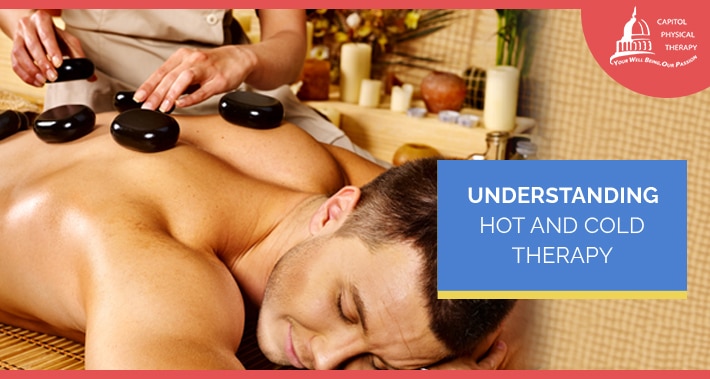
Have you ever ran your hand under cold water after receiving a minor burn?
Or have you ever applied a heat pack to sore muscles after a long work out?
These homemade approaches to pain management are examples of heat and cold therapy.
Of course, seeing a Washington DC physical therapist for heat and cold therapy is a little more involved than that.
Unlike many pain management techniques, heat and cold therapy is passive, non invasive, and non addictive.
As a result, it remains a popular option for managing pain.
Let’s take a closer look at heat and cold therapy, how it works, and how your physical therapist might use it.
What Is Heat Therapy?
Heat therapy, or thermotherapy, involves applying heat to inflamed areas in order to dilate blood vessels, promote blood flow, and help relax tight muscles.
Types Of Heat Therapy
Heat therapy comes in many forms, including:
- Applying heating devices, such as an electrical heating pad or a hot compress
- Soaking in a hot bath
- Using heated paraffin wax treatment
Heat therapy can also be moist or dry.
Moist heat therapies, such as hot baths, often work faster than dry heat therapies, such as heat packs.
What Is Heat Therapy Used For?
Heat therapy is an effective solution for the treatment of chronic muscle pain and arthritis joint pain.
Additionally, heat therapy may be useful for a variety of other conditions, including:
- Strains and sprains
- Orthopedic health conditions like sprains and tendinitis
- Headaches
- Pain or muscle spasms due to neck and back injuries, including lower back pain
Heat therapy is also commonly used to warm up stiff muscles before physical activity along with a through dynamic warm up like high knees, kick butts, heel walks, toe walks, carioca, walking kicks, walking lunges, and over the fence, under the fence.
As a result, it’s a great tool for running injuries prevention and treatment
When To Avoid Heat Therapy
In certain instances, heat therapy may exaggerate or worsen pain and other conditions.
For this reason, you should avoid heat therapy if:
- Your skin is hot, red, or inflamed
- You have dermatitis or an open wound
- You feel numb
- You have a condition that affects your sensitive to heat, such as peripheral neuropathy
Additionally, you should talk to your doctor before starting heat therapy if you have been diagnosed with high blood pressure or heart disease.
What Is Cold Therapy?
Cold therapy, or cryotherapy, involves applying ice or other cooling devices in order to reduce blood flow to an injury and subsequently slow the rate of inflammation.
Cold therapy is therefore useful in helping reduce the risk of swelling and tissue damage after an injury.
Types Of Cold Therapies
Like heat therapy, cold therapy comes in many different forms.
These include:
- A cold compress intermittently applied to the inflamed area
- Soaking in a cold, but not freezing, bath
- Massaging the area with an ice cup or an ice pack in a circular motion
What Is Cold Therapy Used For?
Cold therapy is most effective when applied immediately following an injury, such as a sports injury.
Other conditions that may benefit from cold therapy include:
- Osteoarthritis
- Gout
- Strains and sprains
- Irritation of the tendons after physical activity (tendinitis)
- Migraines
When To Avoid Cold Therapy
In certain instances, cold therapy may exaggerate or worsen pain and other conditions.
For this reason, you should avoid cold therapy if:
- You feel numbness
- You have an open wound of blistered skin
- You have a vascular disease or injury, such as carotid artery disease
- You have a nerve disorder that affects blood flow, such as sympathetic dysfunction
- You have a disorder that causes you to be hyper sensitive to cold, like Reynaud’s disease
Cold therapy should also be avoided right before physical activity.
Additionally, you should talk to your doctor before starting cold therapy if you have been diagnosed with high blood pressure, heart disease, or vascular disease.
When To Alternative Between Heat And Cold Therapy
In some instances, alternating between heat and cold therapy can be extremely beneficial.
Cold therapy causes your blood vessels to contract, your circulation to reduce, and your pain to decrease.
By applying heat after cold therapy, your veins begin to expand again, your circulation improves, and nutrients are carried through your blood to the injury site to stimulate healing.
Alternating between heat and cold therapy may be beneficial for certain conditions, such as osteoarthritis and exercise induced injuries.
Book Your Appointment With Capitol Physical Therapy Today
Are you unsure if heat and cold therapy is right for you?
We can help!
At Capitol Physical Therapy, we can teach you how to implement heat and cold therapy into your wellness and recovery plan while also treating the cause of your pain.
Book your appointment with Capitol Physical Therapy today to find out more.
1331 H St NW #200,
Washington, DC 20005
- https://g.page/capitolptdc
9560 Pennsylvania Ave. # 202,
Upper Marlboro, MD 20772
- https://goo.gl/maps/zjL4NnnuThRhrcS86
Capitol Physical Therapy offers orthopedic and other pain related solutions, with our versitile team of physical therapists in Washington, DC